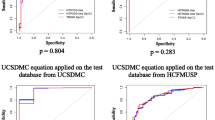Abstract
Objective:
Evaluating processes of care and outcomes of injured patients are important if improvements in the quality of care delivered to injured patients are to be accomplished. We applied a customized ASCOT model developed from our database as a tool to criticize the quality of care in a local hospital.
Patients and Methods:
A total number of 4,096 trauma patients were used to develop new coefficients for customization of ASCOT. These patients were divided randomly into two equal groups. New coefficients for ASCOT were derived from the first set of patients. The newly developed model was validated in the second group of patients and the measures of discrimination (area under the ROC curve) and calibration (Hosmer–Lemeshow goodness of fit) were calculated. Then we used the customized model to calculate the W score in different subgroups of patients treated in a local hospital to evaluate the care offered to patients in each group.
Results:
The customized ASCOT had a good discrimination (area under ROC curve = 0.9575) and calibration (Hosmer–Lemeshow goodness of fit p value = 0.7628) in the validation dataset. Using the customized model, we calculated W score in different subgroup of patients treated in a local hospital for a period of six months. The quality of care was worst for laparotomy (W = –13.31) and pelvic fracture (W = –5.56) and best for orthopedic (W = 1.76) operations.
Conclusion:
We believe that a customization of ASCOT model when used for evaluation of quality of care in a local hospital can be useful for detection of defects and improvement of the process of care delivered to the patients.
Similar content being viewed by others
References
Champion HR, Sacco WJ, Hannan DS, Lepper RL, Atzinger ES, Copes WS, Prall RH. Assessment of injury severity: the triage index. Crit Care Med 1980;8:201–8.
Champion HR, Copes WS, Sacco WJ, Lawnick MM, Bain LW, Gann DS, Gennarelli T, Mackenzie E, Schwaitzbergs S. A new characterization of injury severity. J Trauma 1990;30: 539–45.
Pillgram-Larsen J, Marcus M, Svennevig JL. Assessment of probability of survival in penetrating injuries using the TRISS methodology. Injury 1989;20:10–12.
Cvetkovic A. TRISS analysis of trauma care: a Yugoslav perspective. Injury 1992;23:511–4.
Hou LF, Tsai MC. Comparison between of TRISS and ASCOT methods — in Tainan area. Trauma and Injury Severity Score. A Severity Characterization of Trauma. Kaohsiung. J Med Sci 1996;12:691–8.
Moini M, Rezaishiraz H, Zafarghandi MR. Characteristics and outcome of injured patients treated in Urban Trauma Centers in Iran. J Trauma 2000;48:503–7.
Champion HR, Copes WS, Sacco WJ, Frey CF, Holcroft JW, Hoyt DB, Weigelt JA. Improved predictions from a severity characterization of trauma (ASCOT) over Trauma and Injury Severity Score (TRISS): results of an independent evaluation. J Trauma 1996;40:42–8; discussion 48-9.
Cales RH, Trunkey DD. Preventable trauma deaths: a review of trauma care systems development. JAMA 1985;254: 1059–63.
Moylan JA, Detmer D, Rose J, Schulz R. Evaluation of quality of hospital care for major trauma. J Trauma 1976;16:517–23.
Cayten CG, Stahl WM, Murphy JL, Agarwal N, Byrne DW. Limitations of the TRISS method for interhospital comparisons: a multihospital study. J Trauma 1991;31:471–81; discussion 481-2.
Longest BB Jr. Health policymaking in the United States. (2nd ed.). Health Administration Press, Chicago, 1998:95–133.
Boyd CR, Tolson MA, Copes WS. Evaluating trauma care: the TRISS method. J Trauma 1987;27:370–8.
Author information
Authors and Affiliations
Corresponding author
Rights and permissions
About this article
Cite this article
Moini, M., Rezaishiraz, H., Zarineh, A. et al. Evaluation of Quality of Trauma Care in a Local Hospital Using a Customization of ASCOT. Eur J Trauma Emerg Surg 35, 56–60 (2009). https://doi.org/10.1007/s00068-008-7044-x
Received:
Accepted:
Published:
Issue Date:
DOI: https://doi.org/10.1007/s00068-008-7044-x




